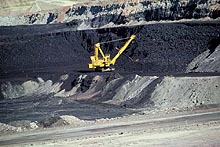How Is Coal Formed?
Answer:

Coal is called a fossil fuel because it was formed from the remains of vegetation that grew as long as 400 million years ago. It is often referred to as "buried sunshine," because the plants which formed coal captured energy from the sun through photosynthesis to create the compounds that make up plant tissues. The most important element in the plant material is carbon, which gives coal most of its energy.
Coal is formed when peat is altered physically and chemically. This process is called "coalification." During coalification, peat undergoes several changes as a result of bacterial decay, compaction, heat, and time. Peat deposits are quite varied and contain everything from pristine plant parts (roots, bark, spores, etc.) to decayed plants, decay products, and even charcoal if the peat caught fire during accumulation.
Peat deposits typically form in a waterlogged environment where plant debris accumulated. Peat bogs and peat swamps are examples. In such an environment, the accumulation of plant debris exceeds the rate of bacterial decay of the debris. The bacterial decay rate is reduced because the available oxygen in organic-rich water is completely used up by the decaying process. Anaerobic (without oxygen) decay is much slower than aerobic decay.
|